Topics
Category
Era
Interstate State Park
The Interstate State Park, located on 295 acres in Taylors Falls, is the second-oldest state park in Minnesota. Created in 1895, its unique topography and geological history draw many visitors to the area. It is the first park in the United States to be located in two states, Minnesota and Wisconsin, with the St. Croix River serving as the border. The two parks are operated separately by the states’ Departments of Natural Resources.
Over one billion years ago, basaltic lava flowed out of the earth to form thick layers of the black rock found along the St. Croix River near Taylors Falls. More than 500 million years ago, an ocean ebbed and flowed over the area, depositing rocks and sea life and creating fossils. Deposits of ocean silt and sand formed shale and sandstone.
Finally, ten thousand years ago, a much larger Glacial St. Croix River, fed by Glacial Lake Duluth, carved out the current river valley by gradually breaking up and eroding the basalt lava flows to create the 100-foot-tall vertical cliffs lining the river. Ten distinct lava flows, more than ten feet thick, exist along the Minnesota side of the river. The area where the river turns and runs through a narrow gorge was named the Dalles of the St. Croix by French explorers. Dalles, in French, means flagstone or slab of rock.
The park’s most famous features are its potholes, which are recognized as the world's deepest and most numerous (over 400) relative to their area. They are located in the area of the park once called the Glacial Gardens. Powerful glacial waters carried and swirled rocks, pebbles, and boulders that created depressions in the hard basalt. When trapped in the low spots, the swirling water and abrasive materials created deeper and deeper depressions that gradually became potholes.
The potholes vary in size and depth. Some have fanciful names, such as bottomless pit, bake oven, devil’s parlor, hourglass, and devil’s alcove. The bottomless pit’s dimensions are twelve to fifteen feet wide and sixty feet deep. Additional potholes, filled with silt, sand, and other debris, await discovery and excavation.
On June 13, 1886, a series of events led to what may be the largest recorded logjam in the world. Winter logging and a dry spring led to low water in the rivers and delayed transporting the logs to the sawmills. When heavy rain caused the rivers to rise, thousands of logs, dumped into the rivers that fed the St. Croix, led to a two-mile-long logjam at the Dalles.
An estimated 125 to 150 million board feet of logs stuck in the narrow river gorge. It was made even worse by the ninety-degree turn in the river at Angle Rock. Two hundred men labored over six weeks to break up the jam using horses, steam engines, steamboats, dynamite, poles, and axes. This event boosted the local economy due to the thousands of visitors watching the activities and the lumberjacks spending their paychecks.
In the late 1800s, several concerned citizens began to lobby the public and legislators to create a state park in the Dalles area. Official protection, they argued, would preserve its natural beauty and deter neglect, vandalism, and logging. In the spring of 1896, a series of lectures promoted the park and described the history of the Dalles area and its potential. Lecturers included the state botanist and geologist. George H. Hazzard, an active park advocate, was appointed as its first superintendent.
In the 1930s, workers in the WPA (Works Projects Administration) and CCC (Civilian Conservation Corps) built structures in two areas of the park: Glacial Gardens and the campground. Both are now on the National Register of Historic Places. The design of the structures, defined by the National Park Service as rustic style, features native materials such as basalt quarried from the area. Rustic-style architecture is labor intensive, finely crafted, and uniquely American. The original structures included a sanitation building, picnic shelter, shelter/refectory, drinking fountains, rest rooms, stone curb, retaining wall, and combination building (rest rooms, laundry, kitchen, utility).
Visitors to the park enjoy geocaching, birding, picnics, kayaking, canoeing, hiking, camping, organized park tours, boat tours, and exploring for wildflowers and diverse flora and fauna. Rock climbing on the basalt cliffs is a popular challenge.
Bibliography
Anderson, Rolf T. Final Report: Minnesota State Park CCC/WPA Rustic Style Historic Resources. [MN: N.p.], 1988.
CCC/WPA Rustic Style Campground, Interstate State Park, National Register of Historic Places Registration Form.
http://focus.nps.gov/nrhp/AssetDetail?assetID=5b0e45ba-0f5e-4a24-95d3-56e856d8b302
CCC/WPA Rustic Style Historic District. Interstate State Park. National Register of Historic Places Registration Form.
http://npgallery.nps.gov/pdfhost/docs/nrhp/text/89001664.pdf
Crawfod, David, et al. Geology of Interstate Park, The St. Croix Dalles, Home of the World’s Deepest Potholes. [MN]: Minnesota Department of Natural Resources, 2009.
http://files.dnr.state.mn.us/destinations/state_parks/interstate/interstate_geology.pdf
Curry, Edna. Minnesota Department of Natural Resources. “The Greatest Logjam Ever!” Minnesota Volunteer 49, no. 288 (September–October 1986): 14–20.
http://webapps8.dnr.state.mn.us/volunteer_index/past_issues/article_pdf?id=563
Federal Writers' Project Guide to 1930s Minnesota. The WPA Guide to Minnesota. St. Paul: Minnesota Historical Society, 2002.
Hazzard, George H., comp. Lectures, Laws, Papers, Pictures, Pointers: Interstate Park; Dalles of the St. Croix; Taylors Falls, Minn., St. Croix Falls, Wis. St. Paul: [Rich and Clymer], 1896.
https://babel.hathitrust.org/cgi/pt?id=umn.319510020643732
Minnesota State Department of Natural Resources. Interstate State Park.
http://www.dnr.state.mn.us/state_parks/interstate/index.html
Minnesota State Department of Natural Resources. Interstate State Park Management Plan, February, 2009.
http://files.dnr.state.mn.us/parks_recreation/mgmtplans/interstate_plan.pdf
National Park Service. Saint Croix National Scenic Riverway WI, MN.
https://www.nps.gov/sacn/index.htm
Ojakangas, Richard W. Roadside Geology of Minnesota. Missoula, MT: Mountain Press Publishing Company, 2009.
SD1IN a1
"Last Notice" flier
3D Objects Collection, Minnesota Historical Society, St. Paul
Description: Paper flier created on May 7, 1913, to address the issue of banning cows from Interstate State Park.
http://collections.mnhs.org/cms/display.php?irn=10467010
St. Paul and Duluth Railroad Company. A Few Notes Regarding Inter-State Park and Dalles of the St. Croix River, 1899. [St. Paul]: St. Paul and Duluth Railroad Company, 1899.
Wisconsin Department of Natural Resources. Wisconsin State Park System.
http://dnr.wi.gov/topic/parks/name/interstate/
Related Resources
Secondary
Green, Doris. Minnesota Underground & the Best of the Black Hills: A Guide to Mines, Sinks, Caves, and Disappearing Streams. Black Earth, WI: Trails Books, 2003.
McMahon, Eileen M., and Theodore J. Karamanski. North Woods River: The St. Croix River in Upper Midwest History. Madison, WI: University of Wisconsin Press, 2009.
Meyer, Roy W. Everyone’s Country Estate: A History of Minnesota’s State Parks. St. Paul: Minnesota Historical Society Press, 1991.
Minnesota State Department of Natural Resources. Interstate State Park Bird Checklist. [MN]: The Department, 2004.
http://files.dnr.state.mn.us/destinations/state_parks/interstate/bird_checklist.pdf
Minnesota State Department of Natural Resources. Interstate State Park. Climber Information. [MN]: The Department, n.d.
http://files.dnr.state.mn.us/destinations/state_parks/interstate/climbing_brochure.pdf
Minnesota State Department of Natural Resources. Interstate State Park Wildflower Checklist. [MN]: The Department, n.d.
http://files.dnr.state.mn.us/destinations/state_parks/interstate/interstate_wildflower_checklist.pdf
Morse-Kahn, Deborah. The Historic St. Croix Valley: A Guided Tour. St. Paul: Minnesota Historical Society Press, 2010.
Robbins, Mary C. “The Dalles of the St. Croix, Wisconsin and Minnesota.” Garden and Forest: A Journal of Horticulture, Landscape Art and Forestry 10, no. 496 (August 1897): 330–331.
https://books.google.com/books?id=BhkgAQAAMAAJ&pg=PA330&hl=en#v=onepage&q&f=false
Related Images
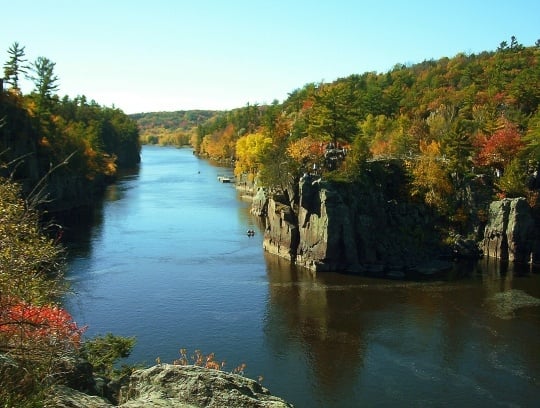
Dalles of the St. Croix River
Public domain
Articles
More Information
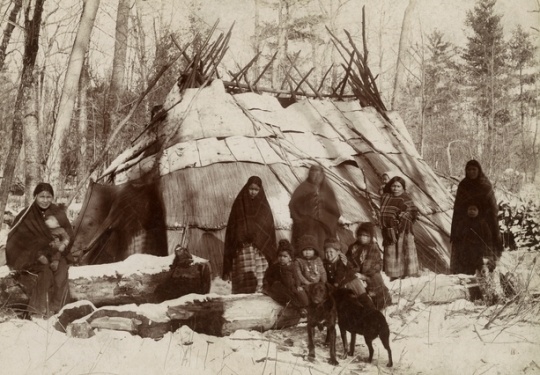
Ojibwe on the St. Croix River
Public domain
Holding Location
More Information
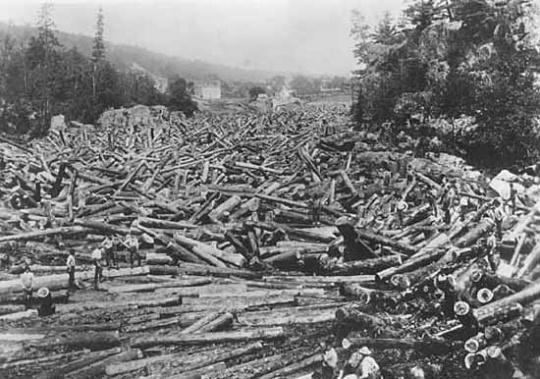
Log Jam at Taylors Falls
Public domain
Holding Location
Articles
More Information

George Henry Hazzard
Public domain
Holding Location
Articles
More Information
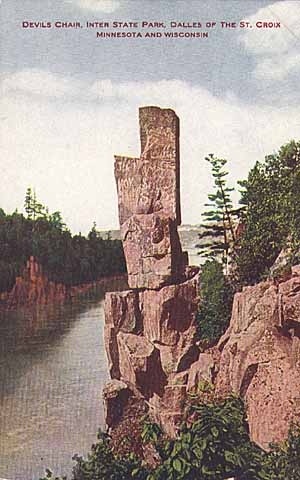
Devil’s Chair, Dalles of the St. Croix
Public domain
Holding Location
Articles
More Information
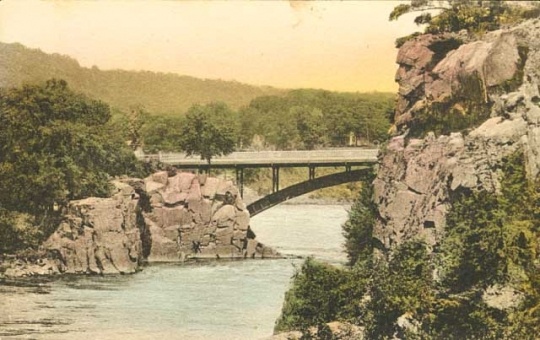
Old Man of the Dalles of the St. Croix
Public domain
Holding Location
Articles
More Information
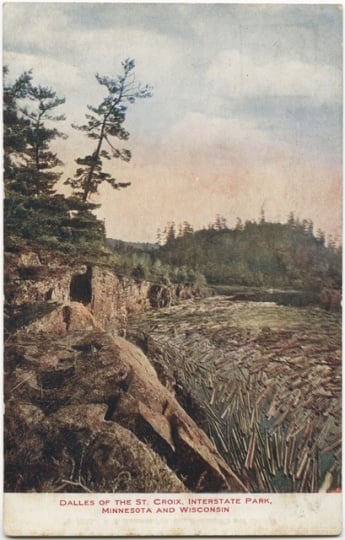
Dalles of the St. Croix
Holding Location
Articles
More Information
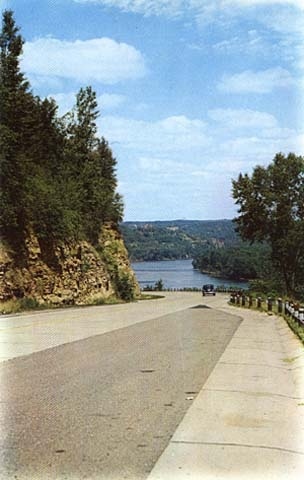
Highway 8 entering Interstate Park
Holding Location
Articles
More Information
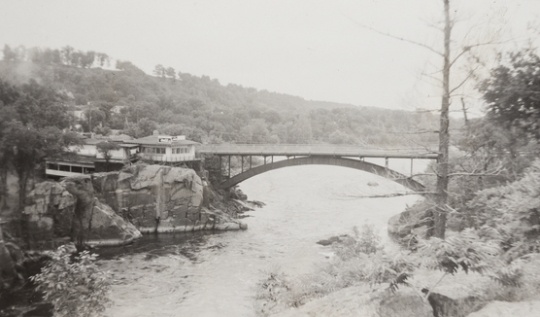
View of Showboat Inn and Interstate Bridge
Holding Location
Articles
More Information
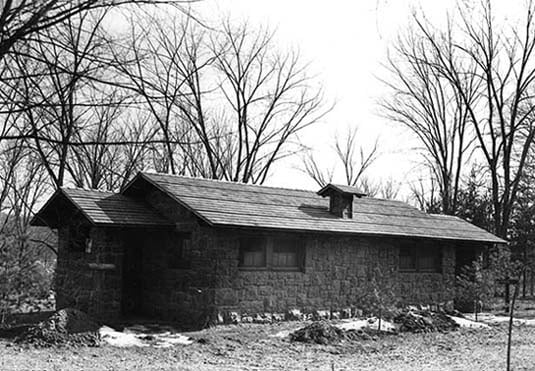
Interstate State Park comfort station
Holding Location
Articles
More Information
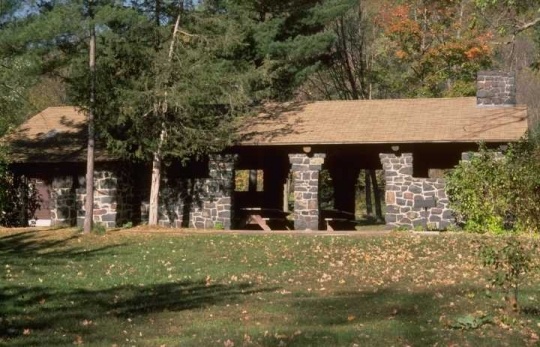
Shelter/refectory at Interstate State Park
Holding Location
Articles
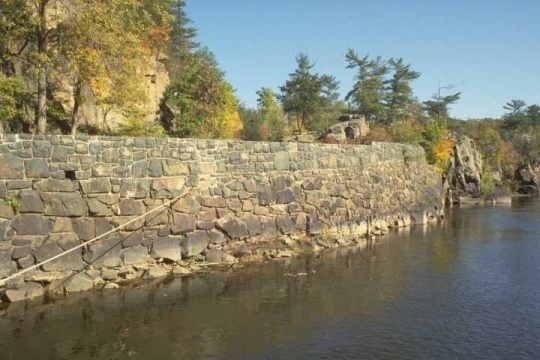
Interstate State Park retaining wall
Holding Location
Articles
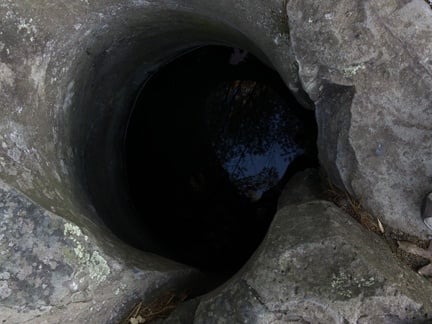
Pothole at Interstate State Park
Holding Location
Articles
.jpg)
Spring Trillium at Interstate State Park
Holding Location
Articles
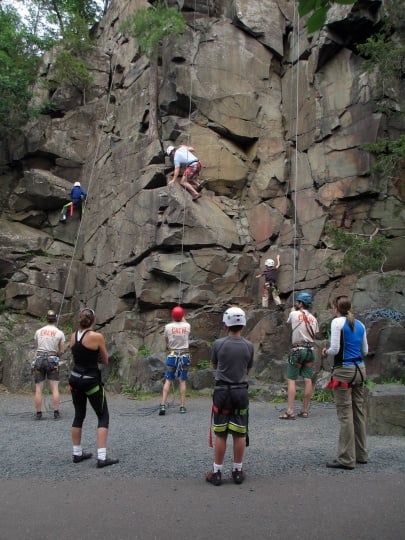
Rock climbers at Interstate State Park
Holding Location
Articles
.jpg)
Bluff trail at Interstate State Park
Holding Location
Articles

Rocky outlook at Interstate State Park
Holding Location
Articles
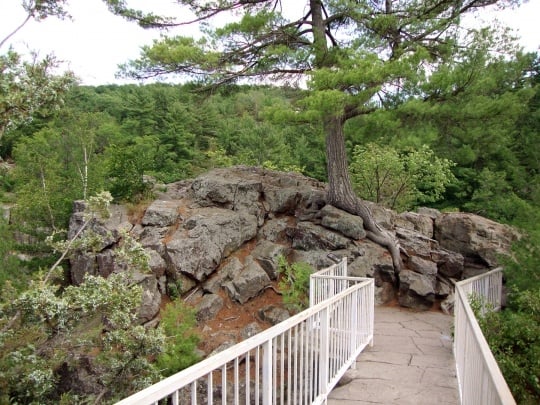
Angle Rock at Interstate State Park
Holding Location
Articles
Related Articles
Turning Point
In 1895, the Minnesota legislature creates the State Park of the Dalles of St. Croix.
Chronology
ca. 3000 BCE
1680
Late 1880s
1886
1895
1896
1899
1900
1913
Mid-1930s
1937
1968
1992
2005
Bibliography
Anderson, Rolf T. Final Report: Minnesota State Park CCC/WPA Rustic Style Historic Resources. [MN: N.p.], 1988.
CCC/WPA Rustic Style Campground, Interstate State Park, National Register of Historic Places Registration Form.
http://focus.nps.gov/nrhp/AssetDetail?assetID=5b0e45ba-0f5e-4a24-95d3-56e856d8b302
CCC/WPA Rustic Style Historic District. Interstate State Park. National Register of Historic Places Registration Form.
http://npgallery.nps.gov/pdfhost/docs/nrhp/text/89001664.pdf
Crawfod, David, et al. Geology of Interstate Park, The St. Croix Dalles, Home of the World’s Deepest Potholes. [MN]: Minnesota Department of Natural Resources, 2009.
http://files.dnr.state.mn.us/destinations/state_parks/interstate/interstate_geology.pdf
Curry, Edna. Minnesota Department of Natural Resources. “The Greatest Logjam Ever!” Minnesota Volunteer 49, no. 288 (September–October 1986): 14–20.
http://webapps8.dnr.state.mn.us/volunteer_index/past_issues/article_pdf?id=563
Federal Writers' Project Guide to 1930s Minnesota. The WPA Guide to Minnesota. St. Paul: Minnesota Historical Society, 2002.
Hazzard, George H., comp. Lectures, Laws, Papers, Pictures, Pointers: Interstate Park; Dalles of the St. Croix; Taylors Falls, Minn., St. Croix Falls, Wis. St. Paul: [Rich and Clymer], 1896.
https://babel.hathitrust.org/cgi/pt?id=umn.319510020643732
Minnesota State Department of Natural Resources. Interstate State Park.
http://www.dnr.state.mn.us/state_parks/interstate/index.html
Minnesota State Department of Natural Resources. Interstate State Park Management Plan, February, 2009.
http://files.dnr.state.mn.us/parks_recreation/mgmtplans/interstate_plan.pdf
National Park Service. Saint Croix National Scenic Riverway WI, MN.
https://www.nps.gov/sacn/index.htm
Ojakangas, Richard W. Roadside Geology of Minnesota. Missoula, MT: Mountain Press Publishing Company, 2009.
SD1IN a1
"Last Notice" flier
3D Objects Collection, Minnesota Historical Society, St. Paul
Description: Paper flier created on May 7, 1913, to address the issue of banning cows from Interstate State Park.
http://collections.mnhs.org/cms/display.php?irn=10467010
St. Paul and Duluth Railroad Company. A Few Notes Regarding Inter-State Park and Dalles of the St. Croix River, 1899. [St. Paul]: St. Paul and Duluth Railroad Company, 1899.
Wisconsin Department of Natural Resources. Wisconsin State Park System.
http://dnr.wi.gov/topic/parks/name/interstate/
Related Resources
Secondary
Green, Doris. Minnesota Underground & the Best of the Black Hills: A Guide to Mines, Sinks, Caves, and Disappearing Streams. Black Earth, WI: Trails Books, 2003.
McMahon, Eileen M., and Theodore J. Karamanski. North Woods River: The St. Croix River in Upper Midwest History. Madison, WI: University of Wisconsin Press, 2009.
Meyer, Roy W. Everyone’s Country Estate: A History of Minnesota’s State Parks. St. Paul: Minnesota Historical Society Press, 1991.
Minnesota State Department of Natural Resources. Interstate State Park Bird Checklist. [MN]: The Department, 2004.
http://files.dnr.state.mn.us/destinations/state_parks/interstate/bird_checklist.pdf
Minnesota State Department of Natural Resources. Interstate State Park. Climber Information. [MN]: The Department, n.d.
http://files.dnr.state.mn.us/destinations/state_parks/interstate/climbing_brochure.pdf
Minnesota State Department of Natural Resources. Interstate State Park Wildflower Checklist. [MN]: The Department, n.d.
http://files.dnr.state.mn.us/destinations/state_parks/interstate/interstate_wildflower_checklist.pdf
Morse-Kahn, Deborah. The Historic St. Croix Valley: A Guided Tour. St. Paul: Minnesota Historical Society Press, 2010.
Robbins, Mary C. “The Dalles of the St. Croix, Wisconsin and Minnesota.” Garden and Forest: A Journal of Horticulture, Landscape Art and Forestry 10, no. 496 (August 1897): 330–331.
https://books.google.com/books?id=BhkgAQAAMAAJ&pg=PA330&hl=en#v=onepage&q&f=false















.jpg?width=200&height=200&name=Trillium%20(10).jpg)

.jpg?width=200&height=200&name=080710%20Bluff%20trail%20(30).jpg)

